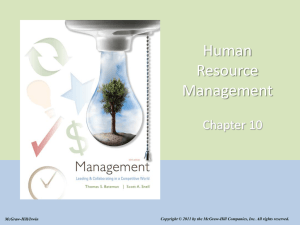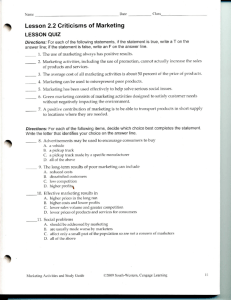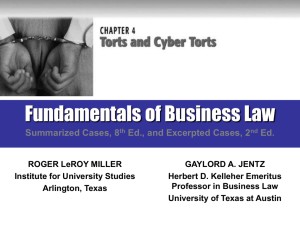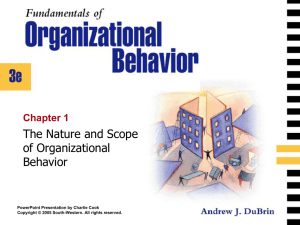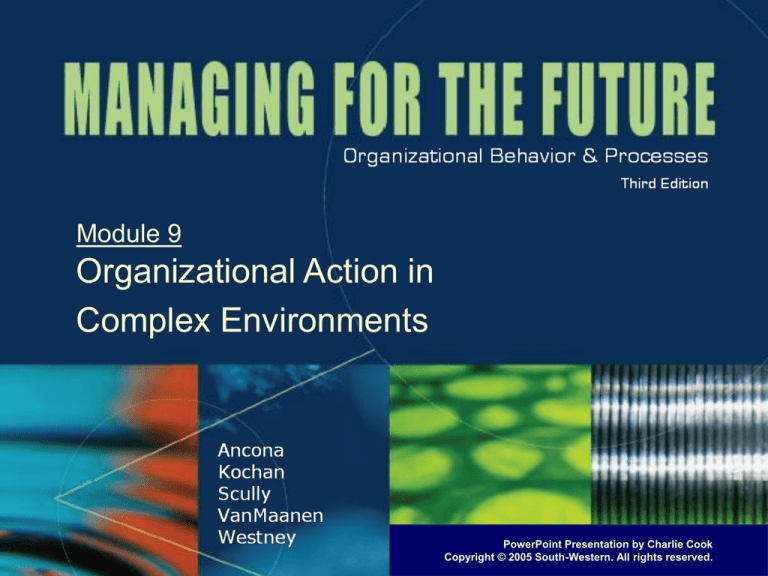
Module 9
Organizational Action in
Complex Environments
PowerPoint Presentation by Charlie Cook
Copyright © 2005 South-Western. All rights reserved.
Strategic Design Perspective:
“Organization Set”
• Organization set model maps resource
environment in terms of input set and output set
Input set includes organizations that provide required
inputs (materials, components, human resources,
financial resources, technology, knowledge)
Output set includes customers for organization’s
output of goods and services as well as distributors,
retailers, service organizations, etc.
Class Notes: Organizations and Their Environments
Copyright © 2005 South-Western. All rights reserved.
9–2
Strategic Design Perspective (cont’d)
• Two additional elements of organization set:
Regulatory set—organizations with formal authority to
regulate internal processes, size of input and output
sets, and kinds of relationships organization is allowed
to build
Set of competitors—competitors may also be parts of
input set
Class Notes: Organizations and Their Environments
Copyright © 2005 South-Western. All rights reserved.
9–3
Strategic Design Perspective:
The Organization Set Model
Class Notes: Organizations and Their Environments
Copyright © 2005 South-Western. All rights reserved.
Figure 9.1
9–4
Strategic Design Perspective (cont’d)
• Internal inking mechanisms
Liaison or integrator positions
Temporary boundary-spanning groups
Permanent boundary-spanning groups
IT systems
Class Notes: Organizations and Their Environments
Copyright © 2005 South-Western. All rights reserved.
9–5
Strategic Design Perspective (cont’d)
• External linking mechanisms
Performance measurement systems
Incentive systems
Resource allocation
Human resource development
Class Notes: Organizations and Their Environments
Copyright © 2005 South-Western. All rights reserved.
9–6
Political Perspective:
Stakeholders Model
• Distinction may be made between internal and
external stakeholders
• Stakeholder model focuses on two key variables:
Interests
What does each set of stakeholders want?
How clearly defined are those interests?
What are the priorities assigned to those interests, and can
priorities be altered?
Power and influence
What is the basis of power or influence of each set of
stakeholders over the organization?
Class Notes: Organizations and Their Environments
Copyright © 2005 South-Western. All rights reserved.
9–7
Political Perspective:
Stakeholders Model
Class Notes: Organizations and Their Environments
Copyright © 2005 South-Western. All rights reserved.
Figure 9.2
9–8
Political Perspective (cont’d)
• Key tools for action in organization-environment
relations:
Mobilization of the interests of external stakeholders
Coalition-building between internal and external
stakeholders and among external stakeholders
Cooptation as one stakeholder or set of stakeholders
gets others to accept its own agenda, either through
persuasion or through offering to further their interests
in some way
Class Notes: Organizations and Their Environments
Copyright © 2005 South-Western. All rights reserved.
9–9
Political Perspective (cont’d)
• External stakeholders generally have a lower
stake in an organization than internal
stakeholders
• External stakeholders can use influence over
organization to obtain outcomes desired by a set
of internal stakeholders
• External stakeholders can use same key tools for
action to influence an organization
Class Notes: Organizations and Their Environments
Copyright © 2005 South-Western. All rights reserved.
9–10
Cultural Perspective:
Institutional Fields
• Shared ways in which people see and interpret
social context are as important to understanding
organizations as resources and power
• Organizations are embedded in a social system
of expectations, taken-for-granted ways of doing
things, status, and legitimacy
• Institutional field concept analyzes interactions
between organizations and their environments
Class Notes: Organizations and Their Environments
Copyright © 2005 South-Western. All rights reserved.
9–11
Cultural Perspective (cont’d)
• Institutional field
Key suppliers, resource and product consumers,
regulatory agencies, and other organizations that
produce similar services or products
• Institutionalization
The process by which certain organizational patterns
come to be accepted as legitimate, as the right way or
only way to do things
Class Notes: Organizations and Their Environments
Copyright © 2005 South-Western. All rights reserved.
9–12
Cultural Perspective:
Institutional Field Model
Class Notes: Organizations and Their Environments
Copyright © 2005 South-Western. All rights reserved.
Figure 9.3
9–13
Cultural Perspective (cont’d)
• Isomorphism
The processes by which organizations become similar
to others in their field
Coercive isomorphism—when a powerful organization or
stakeholder imposes its structural and procedural demands on
an organization
Normative isomorphism—when professional or interest groups
insist that such patterns are the “right” way to do things
Mimetic isomorphism —when organizations take successful
organizations as their models
Class Notes: Organizations and Their Environments
Copyright © 2005 South-Western. All rights reserved.
9–14
Cultural Perspective (cont’d)
• Institutional field model has displaced older
concept of national culture
• National culture models don’t allow for:
Variations within countries across corporate cultures
Changes occurring in organizational patterns over time
• Institutional field model addresses both these
points
• Institutional field model is at the center of debates
over globalization
Class Notes: Organizations and Their Environments
Copyright © 2005 South-Western. All rights reserved.
9–15
Integrating Perspectives
• Organization set model focuses on how tools of
organization design can be used to improve
interorganizational relationships
• Stakeholders model directs attention to how
external stakeholders can influence organization
decision making
• Institutional field model highlights importance of
external models, legitimation, and attention from
external structuring agencies
Class Notes: Organizations and Their Environments
Copyright © 2005 South-Western. All rights reserved.
9–16



